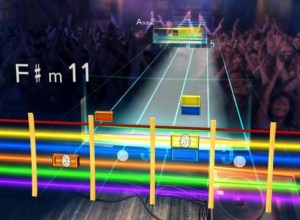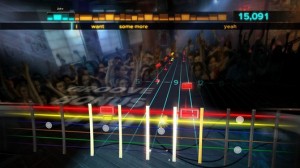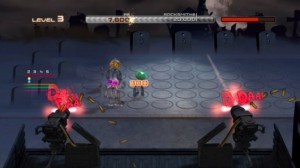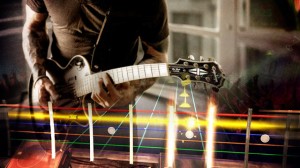 When asked about his name, Joe Strummer said, “With me, you either get all of the strings or none of them.” His propensity for playing every string on the guitar allowed him to strum his way to punk super-stardrom. As we moved from the self indulgence of prog rock and wanky guitar noodling into the punk era, the likes of Joe Strummer showed that anyone could pick up a guitar and make music without practising alone in their bedroom for ten years. If you could strum a few power chords, were angry and had something to say, punk opened the door for you. I never progressed past Joe. That’s as far as I got with guitar. A few power chords, some open chords and lots of strumming, and a complete inability to play anything but all six strings at once. Could Rocksmith make me a better guitarist, and entertain me as a gamer at the same time?
When asked about his name, Joe Strummer said, “With me, you either get all of the strings or none of them.” His propensity for playing every string on the guitar allowed him to strum his way to punk super-stardrom. As we moved from the self indulgence of prog rock and wanky guitar noodling into the punk era, the likes of Joe Strummer showed that anyone could pick up a guitar and make music without practising alone in their bedroom for ten years. If you could strum a few power chords, were angry and had something to say, punk opened the door for you. I never progressed past Joe. That’s as far as I got with guitar. A few power chords, some open chords and lots of strumming, and a complete inability to play anything but all six strings at once. Could Rocksmith make me a better guitarist, and entertain me as a gamer at the same time?
The answer is yes. Rocksmith is fun, and it has also made me measurably, objectively better at playing guitar. The success that Ubisoft have achieved with this title is as surprising as it is impressive.
I started learning to play guitar at 30. A very late start, nonetheless I loved playing and had fun practising every day. When I was very kindly bought a nice guitar, I loved playing even more. I found it hard to learn myself though. Guitar language was mysterious and strange to me, and talk of riffs, frets, bridges and other such terms left me feeling confused and isolated. Assuming some of you readers will be in the same boat, I will try to explain any guitar terminology I use in this review as much as I can and assume you have no prior knowledge of guitar playing. If you are already an awesome guitarist then you don’t need this game, although it would still be fun. It’s a game about teaching you guitar though, so I will assume you have a similar low level of experience (or have no experience at all).
So what is Rocksmith? Well, its a rhythm action game like Rock Band or Guitar Hero, but one where you can plug your own guitar (or bass) into your console through a special cable and adapter you get enclosed in the box. It has the twin goals of teaching you guitar and being a fun game. To play it you need to have your own electric guitar, but almost anything will do, from an expensive Les Paul to an old non-branded piece of wood with strings.
 At its most basic, you play along with songs like you do in other music games. Notes come towards you on a grid on screen and you play them in time on your real guitar. There’s a whole selection of licensed tracks featuring artists from the Rolling Stones to Incubus and every note you play on your guitar is played through the game too, as if you were playing with your speakers at home as your amplifier. If you’re playing well then you are not just mimicking the actions of playing a song, you really are playing the song. At the highest difficulty you are basically playing every note and every part of the song just like the members of the band would if they were on stage.
At its most basic, you play along with songs like you do in other music games. Notes come towards you on a grid on screen and you play them in time on your real guitar. There’s a whole selection of licensed tracks featuring artists from the Rolling Stones to Incubus and every note you play on your guitar is played through the game too, as if you were playing with your speakers at home as your amplifier. If you’re playing well then you are not just mimicking the actions of playing a song, you really are playing the song. At the highest difficulty you are basically playing every note and every part of the song just like the members of the band would if they were on stage.
As well as a guitar, the game really benefits from an external speaker set up. It explains this during set up, but essentially if you are outputting your sound through an HDTV (as many will be) then you will experience lag between what you play and what you hear. Its definitely an issue. From the time that you pluck a string to hearing it there is a real, palpable delay if you don’t have external speakers, and it makes playing less fun. Despite this, in my experience it doesn’t make it harder to play the game. I found that even with the lag I was still able to do well in the challenges and make progress. The only times I found it to be an issue were when I was messing around with the in-game amp. Effectively this lets you just mess around on guitar and play what you like, and the disparity between what I played and what I heard knocked my rhythm off. Even if you don’t have external speakers its still playable, but if you do have them then it simply works much better.
So to go back to what I was saying in the introduction, I started learning guitar by playing lots of chords. These are shapes you make with your fingers holding down specific strings, and you normally strum all or most of the six strings. As you practice these you find that after a while your fingers make these shapes very naturally and moving from one to the other quickly becomes the thing you practice the most. As some of those four chord videos show you, once you can play just a few chords you can play a great many songs, albeit in a very basic fashion.
Rocksmith is far more interested in teaching you the things I found to be much harder first. Riffs. Soloing. Double stops. That kind of thing. Effectively, it focuses on having you play one string (or sometimes two) at a time. Riffs are little short passages where you play a series of notes not by strumming, but by picking particular strings. Soloing is the same idea, but often in a more complicated or improvisational manner than a riff which typically repeats itself. Double stops are simply playing two strings (or notes) at once.
 Diving into the “campaign” of Rocksmith, you are playing little simple riffs from popular songs like “(I Can’t Get No) Satisfaction”. These start very simple, and early songs use the low E and A string (the two ones closest to your face as you play. By sticking to these two strings and making you move your hand up and down to hold the strings at specific frets, you learn how to move your hands up and down the guitar neck, how to hold the string down hard enough and how to pick it in time. It sounds simple enough, but if your only experience of guitar is the games from Activision and Harmonix you will find it hard. Insanely hard. The only way to get better is to practice, and mastery of those games won’t help you one bit. The early stages of playing real guitar involve frustration, sore fingers and disappointment and that’s not Rocksmith’s fault. You either get better or you give up, and while Rocksmith does everything to help you, it can’t craft a well balanced difficulty curve like you can have in any other game. For some things on guitar, it simply goes like this:
Diving into the “campaign” of Rocksmith, you are playing little simple riffs from popular songs like “(I Can’t Get No) Satisfaction”. These start very simple, and early songs use the low E and A string (the two ones closest to your face as you play. By sticking to these two strings and making you move your hand up and down to hold the strings at specific frets, you learn how to move your hands up and down the guitar neck, how to hold the string down hard enough and how to pick it in time. It sounds simple enough, but if your only experience of guitar is the games from Activision and Harmonix you will find it hard. Insanely hard. The only way to get better is to practice, and mastery of those games won’t help you one bit. The early stages of playing real guitar involve frustration, sore fingers and disappointment and that’s not Rocksmith’s fault. You either get better or you give up, and while Rocksmith does everything to help you, it can’t craft a well balanced difficulty curve like you can have in any other game. For some things on guitar, it simply goes like this:
“I can’t do it!
I can’t do it!
I can’t do it!
I can’t do it!
I can’t do it!
I can’t do it!
I can’t do it!
Aaaaaaaggghhh!!!! I can’t do it!
I can’t do it!
I can’t do it!
I can’t do it!
I can’t do it!
Ok, now I can do it.”
Such was my experience with every part of learning guitar. My enemy for the longest time was barre chords. Requiring you to hold down all six strings with the side of your pointing finger while using the others on particular strings, I couldn’t get the hang of these for months. Then one day I could. Such is the nature of learning guitar, and other instruments too I guess. Sometimes you just can’t do something until you can.
So if you are coming in as a complete beginner, you will find the very early stages of Rocksmith to be off-puttingly difficult. The game does everything it can to help, but it’s not going to be easy until you get over the first hurdle of picking notes and fretting.
 Once you do things pick up substantially and you see the fun that can be had with the game… till you get stuck again. Just like real guitar, there will be break throughs, but there will also be points where you get stuck and can’t progress. Rocksmith does well at these moments (more on that later), but when you are slowly progressing through the campaign you feel great. Jumping into “(I can’t get no) Satisfaction”, I found I was playing the signature riff after a few attempts and I felt like I was playing the song for real. I WAS playing the song for real! It’s the one genuinely great thing about Rocksmith. Other games can make you feel like a rock-star, but they will make you no closer to actually being one. With Rockmsith, there is a chance, no matter how small, that you will use what you learn in the game to become a proper guitarist in a band.
Once you do things pick up substantially and you see the fun that can be had with the game… till you get stuck again. Just like real guitar, there will be break throughs, but there will also be points where you get stuck and can’t progress. Rocksmith does well at these moments (more on that later), but when you are slowly progressing through the campaign you feel great. Jumping into “(I can’t get no) Satisfaction”, I found I was playing the signature riff after a few attempts and I felt like I was playing the song for real. I WAS playing the song for real! It’s the one genuinely great thing about Rocksmith. Other games can make you feel like a rock-star, but they will make you no closer to actually being one. With Rockmsith, there is a chance, no matter how small, that you will use what you learn in the game to become a proper guitarist in a band.
The campaign is a lot like Rock Band, with a series of events that you clear by achieving a requisite score. Clearing these events unlocks more to play and more songs too. You gather points as you progress which denote your progress but also unlock bonuses like different guitars, amps, effect pedals and even mini games. This steady treadmill of challenges, events and unlocks makes the game compelling and when you start to encounter songs that give you difficulty then there are lots of little diversions you can go off and explore that you have already unlocked. Many of these diversions, like the mini games, will even help you develop your skills.
If there’s one defining characteristic of my time learning guitar, its becoming “stuck” at something I think I will never be able to do, then suddenly finding out that I can do it. The great thing about Rocksmith is that the developers have made a lot of very clever additions to the basic gameplay formula that help you get over the implicit frustration you feel when you get stuck. You don’t have to just keep playing the same song over and over. If you get stuck at an event, there are so many options to help you get past it. You can practice a riff over and over at a slower speed. You can practice a simplified version of the riff that will get more complex as you hit more of the right notes. You can go and play some of the minigames that are actually fun, but also teach you some fundamental skills like fretting without looking at the guitar. You can swap out songs in an event, meaning that if you don’t like one you can swap it for another. You can even simply lower the score requirement for a song if you think its too high so that you can continue to progress. This flexibility and generosity on the part of the developer is the best design decision they make. They may seem like minor features, but when I started thinking that “Vaseline” by Stone Temple Pilots was the worst song in the whole world, the ability to simply swap it for something else almost made me cry with relief.
 And although all of these features are great I haven’t mentioned the single best thing about the game yet: its dynamic difficulty level. As you play, you will sometimes see the notes coming towards you change, either becoming more or less complex. If you’re doing well, the game dynamically increases the complexity of what you play, making it more and more difficult until you are playing exactly what a real guitarist would play. Meanwhile, if you are struggling the game strips back the number and frequency of the notes and simplifies what you play until you start playing better. It’s occasionally a little disorientating, but generally its a clever and well implemented feature that makes the whole thing far more playable than it would be otherwise. There’s no need to quit songs or pause and change difficulty, you simply play as well as you can and the game gives you a challenge. It both keeps the game interesting and makes you continue to develop as a guitarist.
And although all of these features are great I haven’t mentioned the single best thing about the game yet: its dynamic difficulty level. As you play, you will sometimes see the notes coming towards you change, either becoming more or less complex. If you’re doing well, the game dynamically increases the complexity of what you play, making it more and more difficult until you are playing exactly what a real guitarist would play. Meanwhile, if you are struggling the game strips back the number and frequency of the notes and simplifies what you play until you start playing better. It’s occasionally a little disorientating, but generally its a clever and well implemented feature that makes the whole thing far more playable than it would be otherwise. There’s no need to quit songs or pause and change difficulty, you simply play as well as you can and the game gives you a challenge. It both keeps the game interesting and makes you continue to develop as a guitarist.
Despite all these good design decisions there’s still room for improvement. The mini games include great ideas like hitting the correct note at the right time to score a home-run in baseball, but they are not all unlocked from the start. These are great little time wasters that also teach valuable guitar skills, so why are they locked away when they could benefit total beginners? You also can’t pause a game and quit out when you want to. I guess they want to encourage you to finish a song when you start it, but with so much freedom elsewhere its strange to see them so prescriptive in this one area.
I also found it difficult to read the way the notes are shown on screen. I read guitar tab (but not music), but this didn’t help me understand the strange system of colour coded strings they use. It’s something you get used to eventually, but it took me a long time to get fast at processing what the game was telling me it wanted me to play.
 And if I’m being picky I would also say that purely as a matter of personal taste there was not a single song on the list that I really loved. Some I like, but few stood out and the songs I played in Rocksmith are not the ones I chose to play myself when practising guitar. They’re not even the songs most starting guitarists play. Go to Ultimate Guitar and check the top 100 downloaded tabs and you won’t see any of those in Rocksmith. Its especially galling to see a song from Eric Clapton in there, but no Layla. Come on guys!
And if I’m being picky I would also say that purely as a matter of personal taste there was not a single song on the list that I really loved. Some I like, but few stood out and the songs I played in Rocksmith are not the ones I chose to play myself when practising guitar. They’re not even the songs most starting guitarists play. Go to Ultimate Guitar and check the top 100 downloaded tabs and you won’t see any of those in Rocksmith. Its especially galling to see a song from Eric Clapton in there, but no Layla. Come on guys!
Other issues include long(ish) and regular load times, and the need to check the tuning of your guitar before every song. Thankfully this takes just seconds, and when loading you can normally practice a little and hear the guitar played through the in built amplifier in the game.
The presentation of the game has more in common with Rock Band than Guitar Hero. It’s all dark rooms, dingy basement clubs and muffled audio from backstage. It’s effective enough, and bar the slightly weird looking cardboard cut out audience, the visuals suit the mood and tone of the game. It’s muted, but never ugly.
There are definitely little improvements that could be made but overall Rocksmith is an astonishing success. I was someone who could barely play a two note riff and only ever strummed chords, but after a few days of practice I was slowly getting better at playing simple riffs without looking at the guitar. It might seem like moderate success, but in two years of practice I never managed to do this befaore Rocksmith came along. Joe Strummer never managed this either. The conclusion then has to be that Rocksmith is not only a fun game, but it works. It actually works! Ubisoft promises this game will make you better at guitar, and they are right. Now excuse me while I run off, buy a red Gibson Les Paul and learn how to play “Where is my Mind”!
9 very slightly better guitarist/reviewers out of 10
